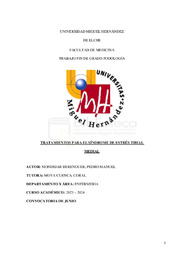Please use this identifier to cite or link to this item:
https://hdl.handle.net/11000/33373Full metadata record
| DC Field | Value | Language |
|---|---|---|
| dc.contributor.advisor | Moyá Cuenca, Coral | - |
| dc.contributor.author | Mondéjar Berenguer, Pedro Manuel | - |
| dc.contributor.other | Departamentos de la UMH::Ciencias del Comportamiento y salud | es_ES |
| dc.date.accessioned | 2024-10-03T08:06:25Z | - |
| dc.date.available | 2024-10-03T08:06:25Z | - |
| dc.date.created | 2024-05-28 | - |
| dc.identifier.uri | https://hdl.handle.net/11000/33373 | - |
| dc.description.abstract | Se habla de “síndrome de estrés tibial medial”, o “periostitis tibial” cuando se produce una lesión por uso excesivo o estrés repetitivo. Actualmente es una de las patologías más frecuentes en el miembro inferior del deportista, concretamente en deportes de impacto, es decir, que conlleven carrera y/o saltos. Se han escogido un total de 13 artículos, en los cuales se han revisado que hablen en concreto de dicha patología, ya que hay mucha controversia; y del tratamiento empleado para la recuperación de esta. Se han encontrado 6 tratamientos diferentes para el síndrome de estrés tibial medial, como son la reeducación de la marcha, medias compresivas, utilización de ortesis plantares, vendajes, terapía física y ejercicios o estiramientos. Tras conocer el amplio abanico terapéutico, se ha visto que la mayoría de los estudios y la mayoría de los tratamientos están enfocados a la utilización de ortesis plantares como tratamiento; ya que las principales causas de lesión son biomecánicas. Por otro lado, se revisa que no existe una mejora significativa en cuanto a la terapia física como tratamiento para la lesión, pero si en una de ellas, como son las ondas de choque empleadas en la zona de lesión. Por último, se concluye que hay bastantes tratamientos disponibles para el síndrome de estrés tibial medial, dependiendo del estadio de la patología. Se reconoce evidencia científica en el empleo de ortesis plantares como tratamiento y cabe destacar que hacen falta más estudios por realizar que confirmen lo concluido en esta revisión y detallen el uso de los tratamientos. | es_ES |
| dc.description.abstract | The term “medial tibial stress syndrome” or “tibial periostitis” refers to an injury caused by overuse or repetitive stress. It is currently one of the most common pathologies in the lower limbs of athletes, particularly in impact sports that involve running and/or jumping. A total of 13 articles were selected, specifically reviewing this pathology, as there is much controversy surrounding it, and the treatment used for recovery. Six different treatments for medial tibial stress syndrome were identified: gait retraining, compression stockings, use of foot orthotics, taping, physical therapy, and exercises or stretching. Upon reviewing the wide range of therapeutic options, it was found that most studies and treatments focus on the use of foot orthotics as a treatment, as the main causes of injury are biomechanical. On the other hand, it was noted that there is no significant improvement with physical therapy as a treatment for the injury, except in the case of shockwave therapy used in the injury area. In conclusion, there are many treatments available for medial tibial stress syndrome, depending on the stage of the pathology. Scientific evidence supports the use of foot orthotics as a treatment, but more studies are needed to confirm the conclusions of this review and to detail the use of treatments. | es_ES |
| dc.format | application/pdf | es_ES |
| dc.format.extent | 33 | es_ES |
| dc.language.iso | spa | es_ES |
| dc.publisher | Universidad Miguel Hernández | es_ES |
| dc.rights | info:eu-repo/semantics/openAccess | es_ES |
| dc.rights.uri | http://creativecommons.org/licenses/by-nc-nd/4.0/ | * |
| dc.subject | síndrome de estrés tibial medial | es_ES |
| dc.subject | periostitis tibial | es_ES |
| dc.subject.other | CDU::6 - Ciencias aplicadas | es_ES |
| dc.title | Tratamientos para el síndrome de estrés tibial medial | es_ES |
| dc.type | info:eu-repo/semantics/bachelorThesis | es_ES |

View/Open:
1801_ MONDEJAR BERENGUER, PEDRO MANUEL_.pdf
1,14 MB
Adobe PDF
Share:
.png)
